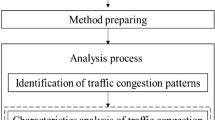Abstract
Congestion is the main feature of traffic in megacities, which has led to severe problems for energy and the environment. At the same time, moving vehicles as the traffic participants can real-time feedback fundamental traffic parameter information such as the interval velocity, average energy consumption and so on. This paper does research on the division of Beijing road which is the basis to calculate the link energy consumption of Beijing. The paper firstly defined the driving pattern and put forward a clustering model of Beijing road link based on the vehicle-specific power (VSP) distribution. Then, by associating the clustering result and other link attributes, a link-based driving pattern classifier is established. At the end of the paper, some experiments are taken to verify that this method made a great classification accuracy of 86 %.
Access this chapter
Tax calculation will be finalised at checkout
Purchases are for personal use only
Similar content being viewed by others
References
Davis N, Lents J, Osses M (2005) Development and application of an international vehicle emissions model. In: 81st annual meeting of the transportation research board, Washington, DC
Barth M, An F, Younglove T (2000) Comprehensive modal emissions model(CMEM), version 2.0, User’s guide. University of California, Riverside
Koupal J, Michaels H, Cumberworth M et al (2002) EPA’s plan for MOVES: a comprehensive mobile source emissions mode1. US EPA documentation
Jiménez-Palacios JL (1999) Understanding and quantifying moto vehicle emissions and vehicle specific power and TILDAS remote sensing. Ph.D thesis, Massachusetts Institute of Technology , Massachusetts
International Sustainable Systems Research Center, Characterizing emission variations due to driving behavior from onroad vehicles. http://www.issrc.org/ive/
Zhang T, Ramakrishnan R, Livny M (1996) BIRCH: an efficient data clustering method for very large databases. SIGMOD, pp 103–114
Acknowledgments
This research was supported by Megalopolis Advanced Transportation Operate Coordinate Command Platform Program (No. 2010ZX01045-001-009-1).
Author information
Authors and Affiliations
Corresponding author
Editor information
Editors and Affiliations
Rights and permissions
Copyright information
© 2013 Springer-Verlag Berlin Heidelberg
About this paper
Cite this paper
Chi, J., Huang, J., Du, B., Mao, Z. (2013). Division of Beijing Road Based on the Driving Pattern. In: Lu, W., Cai, G., Liu, W., Xing, W. (eds) Proceedings of the 2012 International Conference on Information Technology and Software Engineering. Lecture Notes in Electrical Engineering, vol 211. Springer, Berlin, Heidelberg. https://doi.org/10.1007/978-3-642-34522-7_18
Download citation
DOI: https://doi.org/10.1007/978-3-642-34522-7_18
Published:
Publisher Name: Springer, Berlin, Heidelberg
Print ISBN: 978-3-642-34521-0
Online ISBN: 978-3-642-34522-7
eBook Packages: EngineeringEngineering (R0)




